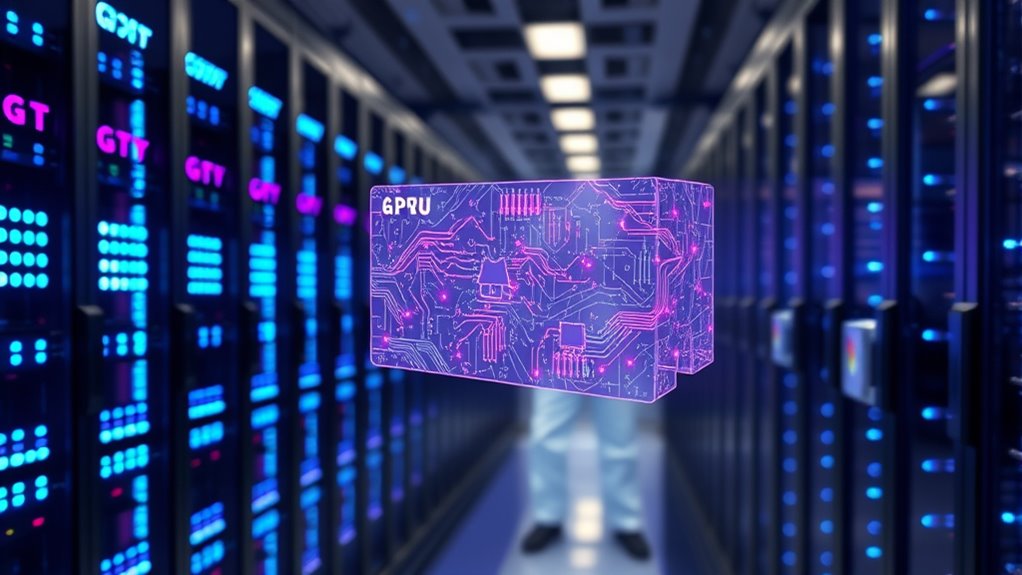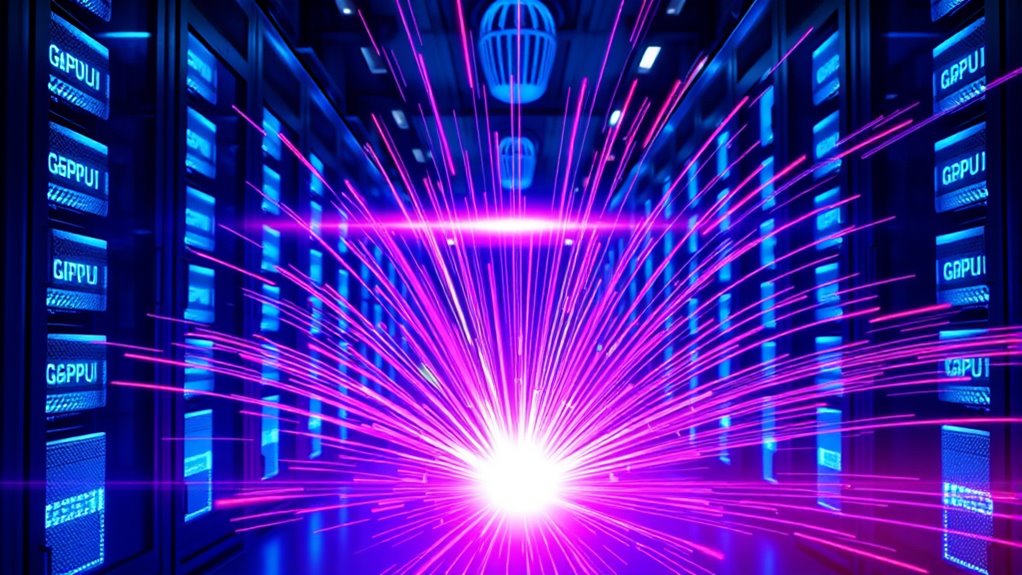Serverless GPUs offer you on-demand, scalable access to high-performance GPU resources without the hassle of managing infrastructure. They let you burst your AI workloads easily, so you can handle fluctuating demands without upfront costs or complex setup. This approach simplifies resource management, improves cost efficiency, and enables quick experimentation. If you want to discover how serverless GPUs can boost your AI projects and streamline workflows, there’s plenty more to explore.
Key Takeaways
- Serverless GPUs provide on-demand access to high-performance GPU resources without managing infrastructure.
- They enable “bursting,” allowing AI workloads to scale quickly during peak demand.
- Cost-efficient pay-as-you-go models eliminate upfront hardware investments and reduce idle capacity expenses.
- Simplify workflows by abstracting hardware management, accelerating AI development and experimentation.
- Facilitate seamless scalability from single GPUs to hundreds, supporting flexible and responsive AI projects.

Have you ever wondered how to access powerful GPU resources without managing infrastructure? If you’re involved in AI development or data science, you know that GPU acceleration is essential for training complex models and processing large datasets. Traditionally, setting up and maintaining GPU servers involves significant costs and ongoing management, which can hinder agility and slow down innovation. That’s where serverless GPUs come into play. They offer a way to tap into high-performance GPU resources on demand, without the hassle of infrastructure management. This approach directly addresses two major concerns: cost efficiency and scalability challenges.
With serverless GPUs, you pay only for what you use, making it a cost-effective solution compared to traditional dedicated servers. You don’t need to invest in expensive hardware upfront or worry about underutilized resources during periods of low demand. Instead, you can spin up GPU instances when you need them and shut them down afterward, ensuring you’re not paying for idle capacity. This pay-as-you-go model dramatically improves cost efficiency, especially for projects with fluctuating workloads or experimental phases. It also removes the financial barrier for smaller teams or startups that might not have the budget for dedicated GPU clusters.
Pay only for what you use with serverless GPUs, boosting cost efficiency for fluctuating workloads and startups.
Scalability challenges are another pain point that serverless GPUs help resolve. In conventional setups, scaling involves provisioning additional hardware, which can be time-consuming, costly, and prone to error. You might face bottlenecks if your demand suddenly spikes, causing delays and lost opportunities. Serverless GPU services dynamically allocate resources based on your workload, allowing you to scale seamlessly and quickly. Whether you need a single GPU for a quick test or hundreds for large-scale training, the infrastructure adjusts automatically to meet your needs. This elasticity means you can experiment more freely, optimize your models faster, and respond to changing project requirements without worrying about capacity planning.
Additionally, just like proper storage and management of physical resources can extend the lifespan and reliability of hardware, storage in a cool, dark place can prolong the shelf life of sensitive equipment or supplies used in AI environments. Moreover, serverless GPU solutions abstract away the complexity of managing hardware and drivers. You focus purely on your AI models and data, while the cloud provider handles resource provisioning, maintenance, and updates. This not only saves time but also reduces the risk of errors or compatibility issues that often plague traditional setups. The result is a more agile workflow that accelerates development cycles.
Frequently Asked Questions
How Do Serverless GPUS Compare to Traditional GPU Setups?
Serverless GPUs offer a flexible alternative to traditional GPU setups by utilizing GPU virtualization, which allows you to access powerful resources without managing hardware. Unlike fixed-resource allocation in traditional setups, serverless GPUs scale on demand, saving costs and reducing idle time. You can quickly burst capacity when needed, making them ideal for dynamic workloads. This approach simplifies management and optimizes resource usage, providing a more efficient way to handle AI tasks.
What Are the Main Cost Benefits of Serverless GPU Solutions?
You gain significant cost efficiency with serverless GPU solutions because you pay only for the resources you use, avoiding idle time expenses. This setup allows for better resource optimization, as you can scale GPU power dynamically based on your workload needs. Rather than investing in expensive hardware upfront, you reduce overall costs, making serverless GPUs a smart choice for flexible, budget-conscious AI processing.
Can Serverless GPUS Handle Real-Time AI Inference Tasks?
Yes, serverless GPUs can handle real-time AI inference tasks effectively, especially when combined with edge computing. They reduce latency by processing data closer to the source, enabling faster responses. This setup allows you to scale quickly without managing infrastructure, making it ideal for applications requiring immediate insights. With serverless GPUs, you get the flexibility and low latency needed for real-time AI inference, enhancing your overall system performance.
How Secure Are Serverless GPU Environments for Sensitive Data?
Your data’s security in serverless GPU environments isn’t just good—it’s nearly impenetrable. They use robust data encryption to protect sensitive information both at rest and in transit, ensuring unauthorized access is blocked. Plus, strict access controls restrict who can use and manage resources. While no system is invincible, these environments are designed with security in mind, giving you confidence that your sensitive data stays safe.
What Are the Limitations of Serverless GPU Performance Scalability?
You’ll find that serverless GPU performance scalability faces limitations due to scalability bottlenecks and resource contention. As demand increases, these bottlenecks slow down your workloads because the shared infrastructure struggles to allocate resources efficiently. This can lead to inconsistent performance, especially during peak times. To optimize, you should consider workload patterns and plan for potential resource contention, ensuring your AI tasks run smoothly without unexpected delays.
Conclusion
Imagine effortlessly scaling your AI workloads with serverless GPUs, just like a startup that suddenly boosted its image recognition service during a product launch. By leveraging this technology, you avoid upfront costs and only pay for what you use, making AI more accessible. As you embrace serverless GPUs, you’ll reveal faster innovation and flexibility. It’s the game-changer that lets you focus on building, not managing infrastructure—turning ambitious ideas into reality with seamless, on-demand power.










